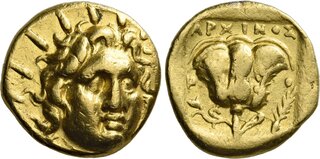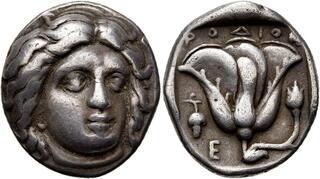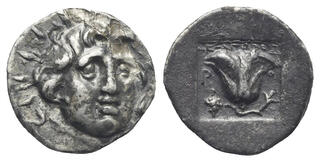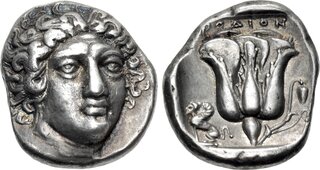Match 1:
Match 2:
Match 3:
Match 4:
Match 5:
| Numismatica Ars Classica > Auction 146 | Auction date: 8 May 2024 |
| Lot number: 2234 Price realized: This lot is for sale in an upcoming auction - Bid on this lot  | |
| Lot description: Rhodes. Hemistater circa 125-88, AV 13 mm, 3.38 g. Radiate head of Helios facing three-quarters r. Rev. P – O Rose with bud l.; above, APXINOΣ and in r. field, palm branch. Jenkins, Essays Kraay-Mørkholm, p. 110, 171. de Luynes 2727. HNO Online 1945 temp. Extremely rare and an issue of great fascination. Several edge marks, possibly traces of mounting, otherwise good very fine From a Distinguished Swiss collection. In the late second and early first centuries BC, Rhodes struck a regular silver coinage of light-weight drachms and hemidrachms that were distinguished from the city's earlier full-weight coinages by the use of an incuse square around the reverse type. Such coins were given the nickname plinthophoroi ("brick-bearers") because the incuse square looked to contemporary Greeks like an impression that might be made by a brick or tile. The reverse of this impressive gold stater clearly indicates that it too belongs to the plinthophoric coin series of Rhodes, but unlike the contemporary silver it is of full Attic weight. This is no accident, as the Attic weight standard had been established already as the international standard for gold coinage since the time of Alexander the Great. It is unclear whether the Attic standard has been used for this coinage merely due to convention or whether the present coin was struck to make a specific foreign payment. Unfortunately, while Hellenistic civic gold coins often reflect an emergency need that could not be covered by silver coinage, it is uncertain what precisely may have motivated the production of this issue. In the late second and early first centuries BC, the economic power of Rhodes was in decline, thanks to increasing Roman involvement in Asia Minor (the province of Asia was created in 129 BC, just shortly before the Rhodian gold series began) and the subtle Roman hostility that had previously led to the creation of Delos as a free port to harm Rhodian trade in 166 BC. Despite these actions detrimental to Rhodes as a trading powerhouse, the island state was considered a free Roman ally and welcomed Roman citizens and Italians fleeing the bloody Asiatic Vespers instigated by Mithridates VI of Pontus and even withstood a major siege to protect them in 88 BC. With the exception of the incuse square on the reverse-the hallmark of the plinthophoric coinage-the types of this stater are very traditional to Rhodes. The obverse depicts the facing head of Helios, who is said to have chosen the island for himself when it first rose from the sea. He named it in honour of the sea nymph Rhode, whom the sun-god married and lived with on the island. In the Hellenistic period, Rhodes was famous for a colossal statue of Helios at the entrance to its harbour, which was considered one of the Seven Wonders of the World. The obverse type depicts a rose (rhodos in Greek) as a punning reference to the name of the island city. Estimate: 10000 CHF |  |









